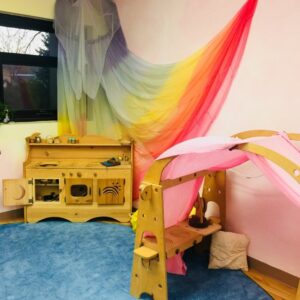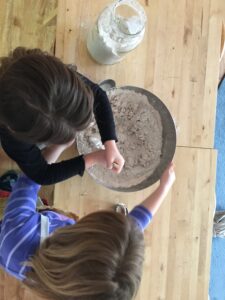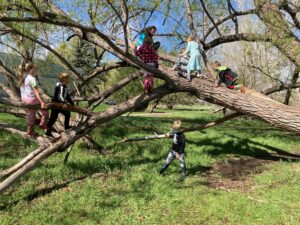
Joyful Learning
The Mountain Sage kindergarten focuses on strengthening each child’s imagination, creativity, social skills, fine and gross motor skills, and sense of self-confidence through a combination of play and hands-on activities.
A Welcoming Class Space
The quality of the Waldorf-inspired educational environment is  integral to our goals for the children. A feeling of warmth and security is created by using only natural materials such as wood, cotton, and wool. The curtains transmit a warm glow into the room. In this welcoming pace children will find toys they can use to imitate and transform the activities that belong to everyday adult life. In one corner might stand a wooden scale and baskets for children to pretend they are grocery shopping; a pile of timber stands ready to be constructed into a playhouse, a boat or a train; homemade dolls lie in wooden cradles surrounded by wooden frames; and cloths the children can use to create a pretend family and play house. Pinecones and flowers are artistically dispersed while lovely watercolors adorn the walls. The effect of this beautiful arrangement of decorations and toys is a feeling of entering a “children’s garden,” where one can breathe easily, relax, and play according to the impulses of one’s heart.
integral to our goals for the children. A feeling of warmth and security is created by using only natural materials such as wood, cotton, and wool. The curtains transmit a warm glow into the room. In this welcoming pace children will find toys they can use to imitate and transform the activities that belong to everyday adult life. In one corner might stand a wooden scale and baskets for children to pretend they are grocery shopping; a pile of timber stands ready to be constructed into a playhouse, a boat or a train; homemade dolls lie in wooden cradles surrounded by wooden frames; and cloths the children can use to create a pretend family and play house. Pinecones and flowers are artistically dispersed while lovely watercolors adorn the walls. The effect of this beautiful arrangement of decorations and toys is a feeling of entering a “children’s garden,” where one can breathe easily, relax, and play according to the impulses of one’s heart.
Play and Learning
Kindergarten introduces the fundamental concepts of mathematics through creative play and daily practical activities. Mathematics begins in the kindergarten with sorting, one-to-one correspondence, counting from 1 to 20, patterning, and identifying shapes. By the end of kindergarten, students understand small numbers, quantities,
Literacy begins in the kindergarten with a rich oral language base. Teachers use storytelling, including classic and modern folk tales from various cultures, to develop students’ attention span, concentration, vocabulary, speaking, and listening comprehension skills. This creates the rich foundation for reading comprehension. Through drama, rhythmic poetry, nursery rhymes, finger plays, and songs, the teachers further immerse the children in vivid and imaginative oral speech and literature.
Children are exposed to a multiplicity of experiences with the natural world. In the physical sciences, students’ creative play involves them deeply in exploring basic physics principles, such as mass, density, gravity, balance, and the creation of pulleys and levers. Life science and earth science start with students observing common objects using their five senses. Students learn to communicate observations orally and through drawings. Nature tables, as well as frequent nature walks provide an awareness of the seasons and a connection to the natural environment. The students experience the cycle of growth through gardening--from seed to harvest to transformation through cooking.
Other activities involve students directly in the transformation of colors and natural materials into useful and beautiful creations. These activities include combining colors in watercolor painting, carding and felting raw wool, making dolls from garden grasses and more. Finger knitting develops fine-motor skills and nurtures children’s ability to focus and concentrate, while fostering hand-eye coordination. Students’ development of fine motor skills and focus is essential for learning to read and write, as well as for doing mathematics and other academic work.
Problem-solving skills have their foundation in creative play, or play that transforms the environment in inventive ways. Creative play provides students with opportunities to imagine, plan, and carry out increasingly complex activities. During creative play, teachers guide students’ growing capacities for creative problem solving and social interaction. Early childhood research shows that free play is serious work for young children, forming the basis for later scientific thought (analytical critical thinking skills and problem solving).
